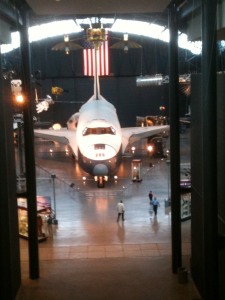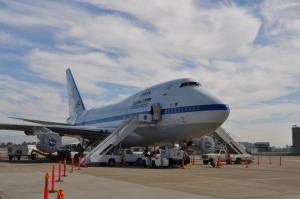Carnival of Space 220: Shuttles, satellites, comets, tweetups, competitions & more
Posted: October 23, 2011 Filed under: Uncategorized | Tags: Beyond Earth, comets, Enterprise, Eta Corvi, Jim Bean writing competition, laser, lunar base, NASA, orion, Pluto, ROSAT, scuba, shuttle, SOFIA, space debris, Spitzer, Sprite, STS127, sts135, tweetup, URAS 7 CommentsHello all and welcome to the round up of what’s been going on in the Universe this week. If you’d like to find out more, or get involved yourself, check out the Carnival’s homepage over at Universe Today.
Before we get started, an important request: Nicole at NoisyAstronomer.com is asking people to help the residents of Louisa County, Virginia, which was the epicenter of the 5.8 magnitude east cost earthquake that happened earlier this year.
Onto the stories, and let’s begin with some space-travel news. NASA Space Flight gives an update on the progress New Orleans engineers are making on the Orion Multi-Purpose Crew Vehicle. The current aim is for this vehicle to blast off into orbit in 2013, with later missions aiming for the moon and perhaps beyond.
In other NASA news, Next Big Future report on news that the Space Agency hid the cheaper cost of in-space fuel depots to get a heavy lift rocket. They also cover Robert Bigelow’s prediction that China will have claimed large parts of the moon as its territory before 2030.
If NASA’s taking too long for you, how about launching your own spacecraft? For a small donation you can, thanks to the Sprite project.
Time for some history now. Riofrio Spacetime has paid a visit to Enterprise, the test vehicle which made the Space Shuttle program possible, whilst I visited SCUBA, a groundbreaking astronomical instrument which opened up the far-infrared – a previously little-explored wavelength range. Finally Vintage Space tells the story of Apollo 10, the dress rehearsal for the moon landing, and Cheap Astro’s podcast reminisces about the STS127 shuttle mission.
There’s more distant thinking over at Universe Today, where Paul Spudis outlines his plan for an affordable lunar base. It includes a type of ‘transcontinental railroad’ which opens up cislunar space – the area between Earth and the Moon – for development.
Moving out into the Solar System, and Astroblog reports that the remnants of Comet C/2010 X1 Elenin, which disintegrated in August, have been found, whilst Dear Astronomer answers the question “Why isn’t Pluto a planet anymore?” On a related note, the Urban Astronomer writes about the swarms of comets which the Spitzer Space Telescope has detected in the solar system around the star Eta Corvi.
Next up are stories from two tweetups (an informal meeting of people brought together via twitter) that took place recently. Weather Chat and Galileo’s Pendulum share their experiences of meeting astronauts from the final shuttle flight at the STS 135 tweetup in Washington DC. There are some more photos of the event from NASA HQ here. Meanwhile open.NASA and Ian Kluft visited NASA Ames for a tweetup in honour of the Stratospheric Observatory for Infrared Astronomy, or SOFIA (or the aeroplane with a telescope in the back, that flies even though there’s a giant hole cut in the side, as I like to call it). Again, there’s more photos of the event here (including the one above) and here, as well as two videos from the day.
The re-entry of the ROSAT and UARS satellites recently has highlighted the growing problem of space debris. The Space Review revisits the legal implications of potential damage caused by this junk whilst I’ve been learning how lasers might provide the answer. For lots more information on this subject check out the new edition of The Orbital Debris Newsletter.
Nearly done now (it’s certainly been a busy astro-week!) Alice of Alice’s AstroInfo found a star in 2000 and last week it (may have) exploded. She talks about the thrill of discovery, and what the new X-ray observations might mean. Over at the Chandra Blog Jessica Brodsky has been sleuthing through the Chandra archives on a quest to tag the images.
Finally, if these stories have inspired you, here’s two competitions to get your imaginations going. The 2012 Jim Bean Memorial Writing Contest is looking for “science fiction writers who create positive stories about man’s future in space”. No pulp fiction about large-breasted alien ladies in distant galaxies please! If film’s more your thing enter the American Museum of Natural History’s Beyond Planet Earth contest. They’re looking for original, out-of-this-world ideas on the future of space exploration in 3 minutes or less – watch their introductory video to find out more:
SCUBA’s retirement home
Posted: October 17, 2011 Filed under: Uncategorized | Tags: hubble deep field, jcmt, national museum of scotland, scuba, submm 2 CommentsA couple of weeks ago I paid a visit to the newly renovated National Museum of Scotland in Edinburgh. Whilst the new galleries are fantastic (and it’s always great to see dinosaur skeletons) my main focus was on finding the new home of a red cylinder with more than a passing resemblance to a British post box.
This unassuming object is SCUBA – the Sub-mm Common User Bolometer Array – a ground-breaking astronomical instrument which was mounted on the back (or, more accurately, the side) of the James Clerk Maxwell Telescope in Hawaii from 1997 until 2005. It’s job was to trace star formation throughout the Universe by detecting the cold dust surrounding stars, and within galaxies, that’s invisible to optical telescopes. This dust absorbs starlight, heats up (slightly) and re-radiates this stolen energy at longer wavelengths such as the submillimetre (the far-infrared Herschel Space Observatory is also great for this).
SCUBA combined sensitivity with a relatively large field of view, compared to the instruments that proceeded it. This meant that it opened up this hitherto little explored wavelength range, and found unexpected things. One of its most important discoveries were the SCUBA galaxies – extremely dusty, extremely distant, objects undergoing massive amounts of star formation. The image below shows the famous Hubble Deep Field in both optical and submillimetre light. Most of the galaxies seen by Hubble are missing in the SCUBA image, but the ones that are visible are producing around a third of the total optical light present.

The Hubble Deep Field as seen in optical light by Hubble (left), and submm light by SCUBA (right). Image borrowed from http://herschel.cf.ac.uk/science/infrared/astronomy
After its retirement SCUBA returned home to the Astronomy Technology Centre at the Royal Observatory in Edinburgh, where it was built, before moving to its final resting place in the museum. Its successor, the imaginatively titled SCUBA-2, is just entering routine operations in Hawaii. It’s a shame that everyone in the photo above seems determined to ignore it – if you live nearby maybe you could visit it and give it some of the attention it richly deserves.
![]() Holland, W., Robson, E., Gear, W., Cunningham, C., Lightfoot, J., Jenness, T., Ivison, R., Stevens, J., Ade, P., Griffin, M., Duncan, W., Murphy, J., & Naylor, D. (1999). SCUBA: a common-user submillimetre camera operating on the James Clerk Maxwell Telescope Monthly Notices of the Royal Astronomical Society, 303 (4), 659-672 DOI: 10.1046/j.1365-8711.1999.02111.x
Holland, W., Robson, E., Gear, W., Cunningham, C., Lightfoot, J., Jenness, T., Ivison, R., Stevens, J., Ade, P., Griffin, M., Duncan, W., Murphy, J., & Naylor, D. (1999). SCUBA: a common-user submillimetre camera operating on the James Clerk Maxwell Telescope Monthly Notices of the Royal Astronomical Society, 303 (4), 659-672 DOI: 10.1046/j.1365-8711.1999.02111.x




